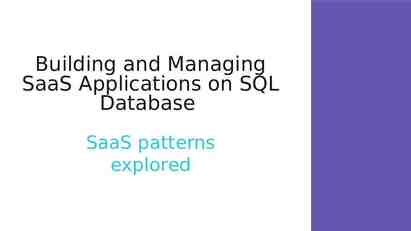BUSINESS ANALYTICS LIVE
41 Slides1.16 MB
BUSINESS ANALYTICS LIVE
Course Outline What will we cover in the next 6-8 weeks 1 2 Excel refresh Querying Data in Managing String data in Excel Computations & Forecasting Tool Data slicing, Analysis & Misc. Statistics for Business Analytics 4 Data Analytics for the Industry Data Analytics Ecosystem Industrial Forecasting Understanding Business Frameworks 7 Pricing Customer Segmentation & Customer Profiling Market Sizing A/B Testing Server Query Language (SQL) 6 Key statistical concepts Hypothesis testing Types of Data and appropriate Visualizations 3 Market Research & Pricing 5 Introduction to Server Query Basic commands Aggregate Functions Grouping and Sorting Aliasing in SQL Power BI Data transformation in Power BI Visualization and Dashboards in Power BI Strategy & Business Frameworks 2
Market Research & Pricing 1. Pricing a) b) Building Pricing and the economics behind pricing Determining Price points to maximize profits 2. Customer Segmentation & Customer Profiling a) b) Understanding customer segmentation Understanding customer profiling 3. Market Sizing a) b) What is market sizing? Approaches to Market Sizing? 4. A/B Testing a) b) What is A/B Testing How to perform A/B Testing 5. Key Performance Indicators
Pricing What is Pricing? Approaches to Pricing Pricing Strategies Pricing Techniques Economics of price setting Price changes & their impact Add a footer 4
WHAT IS PRICING ? Add a footer 5
Primary approaches to Pricing Cost Plus Pricing Value-Based Pricing 6
Cost Plus Pricing A marker manufacturer has the following costs: Variable costs: Rs.30, Fixed costs: Rs. 350,000. Expected unit sales are 50,000. Kindly calculate the Unit Cost. 1. Now suppose the company wants to earn a 20 % markup on sales 2. The company sets a markup price of 57.25. Calculate the desired Return on Sales? 7
Value Based Pricing Value-based pricing is a strategy of setting prices primarily based on a consumer's perceived value of a product or service. Characteristics Needed for Value-based Pricing 1) Product or service that differentiates itself from the competition. 2) The product must be customer-focused, meaning any improvements and added features should be based on the customer's wants and needs. Examples: 3) Fashion Industry 4) Cosmetics 5) Personal Care 8
Pricing Strategies 1 Penetration 2 Economy 3 Skimming 4 Premium 9
Pricing Techniques Linear / Non-Dynamic Price per Unit is same throughout Non- Linear / Dynamic 1 1st Degree Discrimination 2 2nd Degree Discrimination Charging a different price for different quantities of the product sold 3 Consumer Surplus Each unit is priced differently all the while maximizing the price for each unit 3rd Degree Discrimination Charging a different price for a different consumer/customer group 10
Economics of Price Setting Demand Curve Supply Curve Market Equilibrium
Economics of Price Setting How do you ascertain how much to change the price? The answer is in Consumer Surplus
Economics of Price Setting Consumer Surplus: What consumers are willing/able to pay
Economics of Price Setting How to calculate customer response to price changes? Price Elasticity 1 Definition “How sensitive the quantity is to the change in price” 2 Formula % Unit Change: “Percentage change in Qty with Percentage change in Price”
Car Sales Example
Customer Segmentation 1 Customer segmentation is the process of dividing a market of potential customers into groups, or segments, based on different characteristics. The segments created are composed of consumers who will respond similarly to marketing strategies 2 Types of Customer Segmentation. 1) Demographic segmentation. 2) Behavioral segmentation. 3) Psychographic segmentation. 4) Geographic segmentation 17
Clustering Algorithms Affinity Propagation Agglomerative Clustering BIRCH (Balanced Iterative Reducing And Clustering using Hierarchies) DBSCAN (Density based spatial clustering of application with noise) K-Means Mean Shift OPTICS (Ordering points to identify the clustering structure) 18
Customer Segmentation Example 19
Customer Profiling 1 Customer profiling is a way to create a portrait of your customers to help you make design decisions concerning your service. Your customers are broken down into groups of customers sharing similar goals and characteristics and each group is given a representative with a photo, a name, and a description. 20
Approaches to Customer Profiling 1. Psychographic Approach a) Lifestyle and Demographics b) Activities, interests and opinions c) Values, attitudes and social class 2. Consumer Typology Approach a) Loyal Consumers b) Discount Consumers c) Impulsive Consumers 3. Consumer Characteristics Approach 1. Convenience driven 2. Connectivity Driven 3. Personalization Driven 21
Launching a Lunch Box To Mall Customers? A Modular Lunchbox That Unfolds Into An Eating Mat – YouTube The product will cost 300 to produce? What price would help us capture a suitable market ? What approach should we adapt to initiate customer profiling for the product?
Launching a Lunch Box? Possible Customer Segments Based on Age and Revenue To Mall 23
Psychographic Segmentation Canvas GENERAL INFO X X X LIFESTYLE ATTRIBUTES X X X X X DEMOGRAPHICS X X X X ACTIVITIES & INTERESTS X X X X X X X VALUES X X X X X X ATTITUDES X X X X X SOCIAL CLASS X X X 24
What is Market Sizing? FR Market Sizing is the process of estimating the potential of a market Things to look out for and find out 1. Total Size of Potential of the market 2. Major Competition 3. Composition & Profile of target customer 4. Understanding the reach of the product 25
Market Sizing – TAM / SAM / SOM Segment of the TAM targeted by your products and services which is within your geographical reach FR total market demand for a product or service # of opportunities x Avg. S.P # of opportunities x %age of targetable opportunities x Avg. S.P Leather Apparels TAM PKR 5b SAM PKR 500m SOM PKR 6m within 12 months & 20m within 24 months EBITDA margin 9% The portion of SAM that ‘you’ can capture i.e. your ‘market share’ # of opportunities x %age of targetable opportunities x %age of targeted opportunities x Avg. 26 S.P
Example - Uber FR 5.7T Transportation Industry Worldwide 4.2B Taxi and LIMO services in USA 1B in 5 Years Add a footer 27
Approaches to Market Sizing Bottom-Up Addressability Fundamental understanding of the market Company specifics & known market conditions Top-Down Understanding of Macro Economic Indicators Competitiveness & Penetration Addressability
Market Sizing Example Add a footer 29
A/B Testing: What is it? Process of showing two variants of the same web page to different segments of website visitors at the same time and comparing which variant drives more conversions. Businesses want visitors to act (also called a conversion) on their website, and the rate at which a site can drive this is called its “conversion rate.” The more optimized your funnel, the higher is the conversion rate. Typically, in A/B testing, the variant that gives higher conversions is the winning one, and that variant can help you optimize your site for better results. 30
A/B Testing: Why should we do it? 1. Solve Visitor Pain Points 2. Get Better ROI from Existing Traffic 3. Reduce Bounce Rate 4. Make Low-risk Modifications Add a footer 31
How to perform an A/B Test? 1. Research 2. Observe and Formulate Hypothesis 3. Create Variations Test 1 Control Experience Variation 1 Variation 2 Variation 3 32
How to perform an A/B Test? 1. Research 2. Observe and Formulate Hypothesis 3. Create Variations Test 1 Winner Variation 3 33
How to perform an A/B Test? 1. Research 2. Observe and Formulate Hypothesis 3. Create Variations Test 2 Winner Variation 3 Becomes Control Exp Variation 1 Variation 2 Variation 3 Contd 34
Contd 4. Run Tests 1. Split URL Testing 2. Multivariate Testing 3. Multipage Testing 5. Result Analysis and Deployment 35
Example 1: HubSpot's Mobile Calls-to-Action (CTA’s) Audience 44% more likely to click through to an offer landing page and 18% more likely to convert on the offer if all CTAs were stripped except one at the bottom of the page with no ability to exit. Hubspot used 4 variants for this test Variant A: The control, The traditional placement of CTAs Remained unchanged Variant B: CTA had a maximize/minimize options so readers could dismiss CTA Variant C: CTA had an X that would completely dismiss the CTA from the post Variant D: CTA had an no X or minimize/maximize option 36
Example 1: Results Audience 44% more likely to click through to an offer landing page and 18% more likely to convert on the offer if all CTAs were stripped except one at the bottom of the page with no ability to exit. Hubspot used 4 variants for this test Variant A: The control, The traditional placement of CTAs Remained unchanged Variant B: 7.9% increase Variant C: 11.4% decrease Variant D: 14.6% Increase 37
Example 2: Hubspot Email vs. In-App Notification Centre Gathering user reviews is a hard task. Hubspot decided to A/B test ways to reach out to customer for reviews The methods tested were In-App notifications versus email Notifications alerting users that they were monthly champions and would receive a 10 gift if they leave a review Capterra site Variant A: plain text email to users Variant B: HubSpot uses a certification, templated email Variant C: HubSpot sends an in-app notification 38
Example 2: Results In-app notifications are often overlooked or missed by users. The emails outperformed in-app notifications by 1.4x. From both emails, 24.9% of those who opened the email left a review, compared to 10.3% of those who opened the in-app notification. 39
What are Key Performance Indicators (KPI’s)? 40
Key Digital Marketing KPIs 1. Customer Acquisition Cost CAC (total marketing expenses total sales expenses)/# of customer acquired 2. Customer Lifetime value (LTV) CLTV Avg sales per customer X avg # of times a customer buys per year X avg lifetime of a customer (years or months) 3. Digital Marketing ROI DM-ROI (Sales growth – marketing investment)/marketing investment 4. Lead-to-customer ratio 5. Landing page conversion rates Add a footer Contd 41
Key Digital Marketing KPIs 6. Traffic-to-lead ratio Add a footer Website Leads to Marketing qualified Leads Marketing Qualified Lead to Sales Qualified Leads Sales Qualified Leads to Quote Ratios Quoted to Closed Customer Ratio 42














































